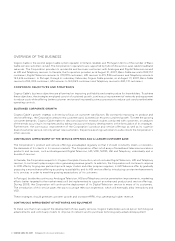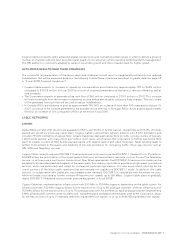Cogeco 2007 Annual Report Download - page 18
Download and view the complete annual report
Please find page 18 of the 2007 Cogeco annual report below. You can navigate through the pages in the report by either clicking on the pages listed below, or by using the keyword search tool below to find specific information within the annual report. 16 COGECO CABLE INC. 2007 Management’s Discussion and Analysis
RISKS PERTAINING TO MARKETS AND COMPETITION
Electronic communications markets are evolving rapidly both in Canada and Portugal and are increasingly competitive.
Rivalry between terrestrial wireline and wireless, as well as satellite service providers is unfolding over individual as well as
bundles of services, including fi xed and mobile voice communications, Internet access, data, audio and video content delivery,
electronic programming guides and navigation tools, security and other related or incidental services. In this converged
environment, competitors strive to meet all the electronic communications needs of residential and business customers
and thus obtain maximum share of their overall electronic communications budget. Rivalry extends over several elements,
including the features of individual services, the composition of service bundles, prices and perceived value, promotional
or introductory offers, duration of the commitment by the customer, terminal devices and customer service.
Cable telecommunications providers have successfully entered into the residential voice communications markets traditionally
dominated by the incumbent telephone companies and they continue to attract a growing base of residential telephone
customers. The telephone companies are increasingly involved in competitive audio and video content delivery, both on their
fi xed and mobile networks, and they continue to dominate the provision of voice and data services to business customers.
The substantial cost of broadband facilities and broadband customer acquisition, combined with the growth of revenue
generating units achieved by competitors generally, tend to make outright price wars on individual services and service
bundles less appealing as a competitive strategy. However, as markets mature and penetration gains for high speed Internet
access, digital video and telephony services abate, retail pricing strategies are likely to become more aggressive, with resulting
downward pressure on operating margins both for individual services and service bundles.
Cogeco Cable provides “double-play” and “triple-play” service bundles both in Canada and in Portugal, with various
combinations of voice, Internet and video distribution services being offered at attractive bundle prices. “Quadruple-play”
service bundles that include mobile communications are becoming available, but so far they have had limited effect on
relative
market shares for double-play or triple-play service bundles. Cogeco Cable continues to focus on its existing lines
of service with a view to capturing the remaining growth opportunities for HSI, Digital Television and Telephony services in
its footprint, making the most effi cient use of its own hybrid fi bre-coaxial (HFC) plant. As markets evolve and mobility becomes
a more cost-effective substitute to wireline communications, Cogeco Cable may need to add mobility components to its
service bundles, through suitable mobile virtual network (MVNO) arrangements with existing or future mobile operators, or
otherwise through new wireless alternatives. The capital and operating expenditures eventually required to offer quadruple-
play service bundles may not be offset by the incremental revenue that such new bundles would generate, thus resulting
in downward pressure on operating margins.
In Canada, Cogeco Cable faces competition in its service areas mainly from a few large integrated telecommunications
service providers. The largest, BCE Inc., offers through its various subsidiaries and income trusts a full range of competitive
voice, data and video services to residential, as well as to business customers in the Provinces of Ontario and Québec through
a combination of fi xed wireline (Bell Canada, Télébec), mobile wireless (Bell Mobility) and satellite (Bell ExpressVu) platforms.
BCE Inc. was the subject of a takeover earlier this year by a group of institutional investors led by the Ontario Teachers’
Pension
Plan, with closing of the transaction expected to take place in the earlier part of 2008. It is not known at this
time to what
extent the changes in the ownership and management of this major competitor will affect market dynamics
in the two
Provinces, notably with respect to the anticipated rollout of IPTV services over its fi xed wireline platform. Telus
Communications
Company competes with all of Cogeco Cable’s services in the Lower St. Lawrence area of the Province of
Québec through the use of its wireline network, and throughout Cogeco Cable’s Canadian footprint through the use of its
mobile telecommu
nications network. However, Cogeco Cable’s Telephony service is provided with the assistance of certain
Telus carrier
services through a multi-year contractual arrangement. Star Choice Television Network Incorporated, an indirect
subsidiary of Shaw Communications Inc., competes for video and audio distribution services throughout Cogeco Cable’s
Canadian footprint.
Rogers Wireless Communications Inc., a subsidiary of Rogers Communications Inc., operates a mobile
telecommunications
network in Ontario and Québec and is the owner of the Inukshuk broadband wireless network in
partnership with Bell
Mobility. Rogers Cablesystems Inc., the cable subsidiary of Rogers Communications Inc. has recently
applied for licensed service area extensions covering the Burlington, Oakville and Milton areas, which are part of Cogeco
Cable’s footprint in
Ontario. Videotron Ltd., an indirect subsidiary of Quebecor Inc., offers competitive mobile telecommuni-
cations services in
Cogeco Cable’s Québec footprint. Cogeco Cable also competes with other telecommunications service
providers, including Vonage, Primus and Rogers Home Phone (formerly known as Sprint), and with alternative service
























